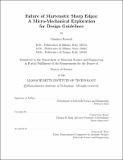| dc.description.abstract | Sharp edges produced today are honed from carbide-rich martensitic stainless steel and applied coatings to achieve high hardness and wear resistance. Yet they become practically unusable upon cutting much softer materials like cheese, potatoes, or human hair.
Although this is an everyday observation, the underlying physical micro-mechanisms are poorly understood due to the structural complexity of the interacting materials, and the complex boundary conditions of their co-deformation. As a result, simplistic guidelines, such as increasing material hardness, are the only ones currently available.
This thesis proposes a new approach to investigate failure of common sharp edges, specifically razor blades cutting human hairs, in order to identify more accurate design guidelines for improved products. This approach consists in the development of new methods for in-situ scanning electron microscope experimental characterization, which enable visualization in real-time of the cutting action of hairs as well as measurement of the cutting force.
Investigations carried out using pristine sharp edges enabled the identification of the mechanical factors governing failure: (i) large mode III component in the stress, (ii) particular position of the hair relative to an asperity along the sharp edge, and (iii) presence of spatial variation of the heterogeneous lath martensite structure along the sharp edge. Combination of these three factors can promote crack propagation at an angle with respect to the sharp edge to form a chip, before other failure mechanisms such as wear or fatigue are activated.
Investigations carried out using corroded sharp edges revealed the detrimental effect produced by the environment on the steel. Due to local chromium depletion in the martensitic matrix because of its segregation into chromium-rich carbides, a percolated void structure forms in the sharp edges due to corrosion. The heterogeneous variation of mechanical properties produced by this structure, in turn, causes cracks to propagate perpendicularly to the sharp edge, thus causing a change in failure mechanism and an increase in failure probability.
The insights gained from these investigations allowed the formulation of new design guidelines for sharp edges, requiring (i) high hardness for wear resistance, (ii) heterogeneity length scale below the sharp edge tip radius for chipping resistance, and (iii) absence of chromium-rich carbides for corrosion resistance.
These guidelines have been implemented through the design of a new manufacturing process that uses tapered rolls to locally severely deform a strip of material into sharp edges. This process creates a gradient in the microstructure from bulk to tip, resulting high strength near the sharp edge thanks to the severe deformation. Preliminary results obtained with pearlitic steel showed promising signs of cementite dissolution. | |
